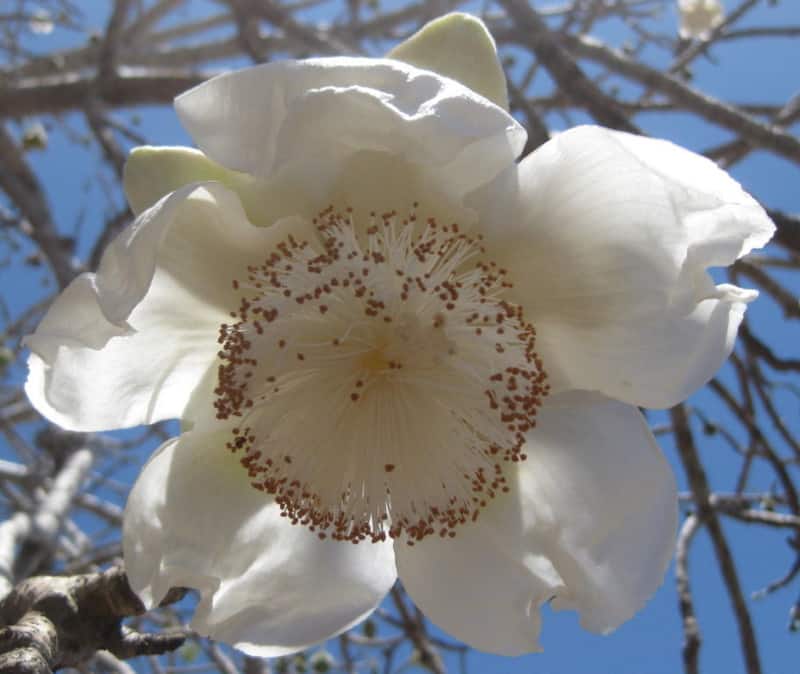Grandidier’s Baobab Facts
- This remarkable tree bears the common name of the Grandidier’s Baobab. To call it distinctive would be an understatement, to say the least. This visually impressive variety of flora also bears a relatively hard to pronounce official scientific name.
- That’s because in scientific circles it’s generally referred to by the longwinded term of Adansonia grandidieri. The French physician and botanist, Henri Ernest Baillon made the first formal recognition of it as a separate and distinct species in the year 1893.
- At the time of that original recognition, Monsieur Baillon named the new species in honor of a fellow French botanist. His name was Alfred Grandidier. Regardless of the name one uses to refer to it, however, it remains an impressive work of Nature.
- Regrettably, this marvel of natural evolution finds itself imperiled. It evolved as endemic to a limited area, which is now shrinking, due to human expansion. Due to this, the IUCN placed the amazing tree on its Red List of Threatened Species, in 2006.
- Unfortunately though, that isn’t the only danger it now faces. It’s also the most heavily exploited of several related species in its habitat range. Humans consume the seeds and pulp of the fruit in large quantities, and also make cooking oil from the seeds.
- In addition to these factors, locals use the bark of the Grandidier’s Baobab to make rope. While all these threaten it, it also faces one more threat, shared with other species around the world. Given its limited range, it’s highly vulnerable to climate change.
Related Articles
Jellyfish Tree
Grandidier’s Baobab Physical Description
The magnificent Grandidier’s Baobab easily impresses those who encounter it. It further does so for a variety of reasons. Though certainly not the primary among these reasons, its sheer size nonetheless remains highly respectable, purely in terms of physical measurments.
The trunks of these true marvels of Nature typically attain heights ranging between 82 – 98 ft (25 – 30 m). These also develop in proportions that can best be described as massive. The diameter of this part of the tree often reaches as much as an impressive 10 ft (3 m).
The majesty of this specific feature of the flora species does simply end there, though. That’s due to the fact that these further display a covering of bark with a highly distinctive nature. This bark manifests as comparatively smooth, and possessing a reddish-gray color.
During certain periods of the year, atop this trunk develops a highly flattened crown. Here, the leaves appear, with their own impressive appearance. These develop as palm-like in design. They also display a striking shade of blusih-green when they reach full maturity.
The Grandidier’s Baobab also contains its own brilliance. That’s because, when it blooms, it does so with majesty. At that time, the crown becomes filled with numerous magnificent flowers, sporting white petals. The large fruits that follow also have kidney-shaped seeds.
- Kingdom: Plantae
- Phylum: Angiosperms
- Class: Eudicots
- Order: Malvales
- Family: Malvaceae
- Genus: Adansonia
- Species: A. grandidieri
Grandidier’s Baobab Distribution, Habitat, and Ecology
Most unfortunately, the stunning Grandidier’s Baobab evolved as native to only a highly restricted portion of the globe. More precisely, it developed on the island of Madagascar. There, it takes its place alongside conutless other fascinating and unique forms of life.
Even there, though, the zone of habitation for this miracle of evolution remains severely restricted. That’s because, to the knowledge of researchers, it only lives in the southwestern portion of the island. That range extends from around Bereboka to Lac Ihotry.
It also appears to display strong preferences for its habitat in terms of altitude. Virtually all specimens live at altitudes ranging from sea level to 200 ft (60 m). It once lived amid a dense tropical deciduos forest. Now, however, it appears in small groves, or singly.
Like its relatives, it also appears to be a long-lived species. The uncertainty exists due to the nature of the tree. It’s internal rings develop in an indeterminate pattern, thereby making precise dating impossible. A roughly estimated lifespan equal about 800 years.
The trees develop leaves from October to May, and their flowers appear from May to August. Uniquely, after appearing, the flowers release all their pollen during the first 24 hours. Despite their beauty, the blooms produce a scent reminiscent of sour watermelons.
The Grandidier’s Baobab further forms an integral part of its ecosystem. Many local animals consume the leaves and fruit. These include two species of lemurs. Several local bird sepcies eat the seeds and nectar of the blooms, along with an indigenous variety of fruit bat.
Species Sharing Its Range
Check out our other articles on 4 Refreshingly Remarkable Rivers, Swift Fox, Atacama Desert, Kerengga ant-like jumper, Anegada ground iguana, Chinese Giant Salamander, Bleeding Tooth Fungus

